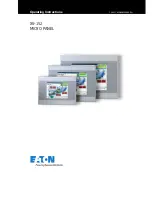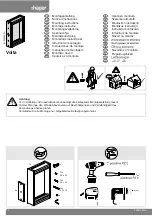
EATON
WCB11070.1
Brake Assemblies Installation, Operation and Maintenance Manual
E-CLCL-II015-E
December 2016
9
WCBD Brake Assemblies
4.1.4 Place the cylinder and piston assembly with the
piston facing down on blocks approximately
6" (150 mm) high. The blocks must only contact the
cylinder (19) so that the piston (33) will be free to
move out of the cylinder bore.
4.1.5 If a regulated air line is available, the piston can be
partially ejected from the cylinder by applying no
more than 15 psig (1.0 bar) to any of the pressure
ports on the cylinder.
Caution
Application of a higher pressure may cause damage
to the components.
4.1.6 To complete the removal of the piston from the
cylinder, open all air inlets. Alternately insert a
0.50" (12 mm) diameter by 6" (150 mm) long wood
dowel or small brass drift into each air inlet and
gently tap the piston with a mallet so that it moves
evenly out of the cylinder. Be careful not to damage
the sealing surfaces of the piston or cylinder by
cocking the piston in the cylinder.
4.1.7 Remove the seals. Note how the lips of the
Inner (21), Outer (23), and Intermediate (114) seals
are oriented. Refer to Figures 1 and 2.
Note: Upon disassembly and inspection, a one-piece seal may be
found for all intermediate seals (114) and on the inner (21) and
outer (23) seals on sizes 18 and larger. These seals have since
been superseded with two seals being installed ‘back-to-back’ as
shown in Figures 1 and 2.
4.1.8 Inspect the cylinder sealing surface condition for
nicks or scratches, corrosion, or any other defect
which may prevent the seals from being effective.
The maximum amount of radial wear on the seal
surfaces is 0.005" (0,13 mm).. The wear on the
sealing surfaces will be in the form of grooves where
the seals contact the cylinder wall. Replace the
cylinder, if necessary.
4.1.9 Thoroughly clean the seal grooves in the piston (33)
and apply a thin coat of Molykote
®
55 O-ring lubricant
to the piston seal grooves and chamfer on the piston,
the sealing surfaces in the cylinder (19), and the
seals (21), (23), and (114).
4.1.10 Install the new seals in the grooves in the
piston, noting the orientation of the seal lips.
See Figures 1 & 2.
4.1.11 Position the cylinder on a flat level surface so that the
pressure cavity faces upward.
4.1.12 Carefully place the piston onto the cylinder with the
chamfered edge of the piston facing downward,
taking special care to avoid damaging the seal lips.
4.1.13 Gradually apply an evenly distributed force to
press the piston into the cylinder being sure not
to cock the piston, which may damage the sealing
surfaces. The use of ’C-Clamps’ may assist with the
assembly process.
4.1.14 Using a lifting strap, slide the cylinder/piston
assembly onto the studs.
4.1.15 Lubricate the threads on the end of the studs with
30 wt. oil or anti-seizing compound and install the
washers (17) and locknuts (18).
4.1.16 While supporting the weight of the cylinder/piston
assembly, tighten the locknuts, ONE TURN AT A
TIME and in an alternating (cross- wise) pattern until
the cylinder is seated firmly against the clamp tubes.
Torque the locknuts to the appropriate value.
See Table 3.
Caution
The locknuts (18) must be tightened gradually to
prevent damage to the WCBD brake assembly's
components.
Table 3
Fastener Description and Assembly Torque - ft.-lb. (Nm)
Item
Description Specification 8WCBD
14WCBD
18WCBD
24WCBD
36WCBD
48WCBD
4
Wear Plate
Size
#10-24NC
1/4-NC2
5/16-18 NC Gr. 8
5/16-18NC Gr. 8
3/8-16NC2 Gr. 8
3/8-16NC2 Gr. 8
Screw
Quantity
42 60 80 90 108
120
5
Locknut
Torque, Dry
5 (7)
12 (16)
21 (28)
21 (28)
40 (54)
40 (54)
18
Locknut
Size
1/2-13NC-3
3/4-10NC-3
3/4-10 NC-3 Gr. 8
1 1/8-7 NC Gr. 8
1 3/8-6 NC Gr. 8
1 3/8-6 NC Gr. 8
Quantity 6
6
12
12
16
16
Torque, Lubed
60 (81)
150 (203)
150 (203)
500 (677)
750 (1016)
750 (1016)
Customer
Mounting
Size
1/2-13 NC-2 Gr. 8
5/8-11NC-2 Gr. 8
5/8-11NC-2 Gr. 8
5/8-11NC-2 Gr. 8
1-8NC Gr. 8
1 3/8-6NC Gr. 5
Supplied Screw
Quantity
4
6
10
10
14
14
Torque, Lubed
70 (95)
150 (203)
150 (203)
150 (203)
660 (895)
1100 (1490)


































